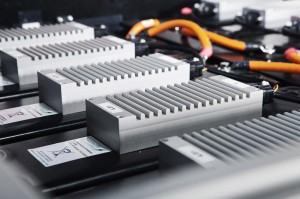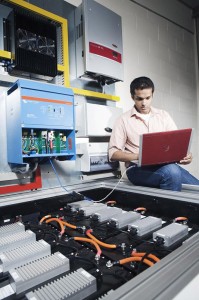A collaborative project in North East England is developing an innovative solution to the problem of successfully exploiting the potential of used batteries from electric vehicles (EVs). The venture explores the possibility of harnessing power in EV batteries as energy storage in a domestic or workplace environment, either for charging vehicles, providing an emergency power source or feeding power back into the grid.
“Although the performance of lithium ion batteries used in EVs dwindles in their original application after eight to 10 years, they maintain around 80 percent of their operational capability, and the challenge is to successfully harness this potential. The project between SR Technology Innovations and tadea, commissioned by Zero Carbon Futures has developed a multi-functional demonstrator unit that can store power from photovoltaic (PV) panels to power the home, charge EVs, feed back into the grid or help manage your power supply to minimize exposure to peak tariffs. The system can also be charged from the grid itself, making it a truly multi-purpose energy storage tool.”
Says Geoff Watson, Zero Carbon Futures technical manager.

As EV adoption becomes more widespread, the problem of finding a useful second-life for the batteries becomes increasingly important. Once commercialised, the system offers immediate benefits to vehicle manufacturers, EV and home owners, but in the medium to long term can help reduce the cost of EVs and battery hire, as battery life can be extended by three-times that of its first in-car usage. The demonstrator kit will be utilised in the North East’s Future Technology Centre, a national centre for low carbon vehicle technologies, and the results assessed to help establish the true potential of this technology.
“The generation of green energy is of growing worldwide focus, and this could represent an efficient storage solution for small-scale solar and turbine energy. For example, power collected during the day could then be released into the home for use at night, or used to charge an EV ready for work in the morning. Installation in line with PV panels can greatly reduce the demand on the national grid and, in the long term, offer considerable savings on energy bills in domestic and commercial application. A secondary source of energy can mean an end to power cuts, the potential for a welcome long-term reduction in energy bills and increasing integration of EVs into the home.”
Explains Dr. Colin Herron, Zero Carbon Futures managing director.
The battery second-life system can be used independently of EV ownership, which maximises the potential benefits of the project once commercialised. As Tim Scott, managing director of SR Technology Innovations explains,
“The system is an extension of our work on hybrid vehicles and electronic control systems technologies. It combines a number of discrete energy solutions and the next step will be to integrate these into a smaller, single package which would be more appropriate for a domestic application and will significantly reduce the cost for the full system. The technology will become increasingly compatible as Europe increases its reliance on green energy production and more homes install photovoltaics.”

Source; Zero Carbon Futures
